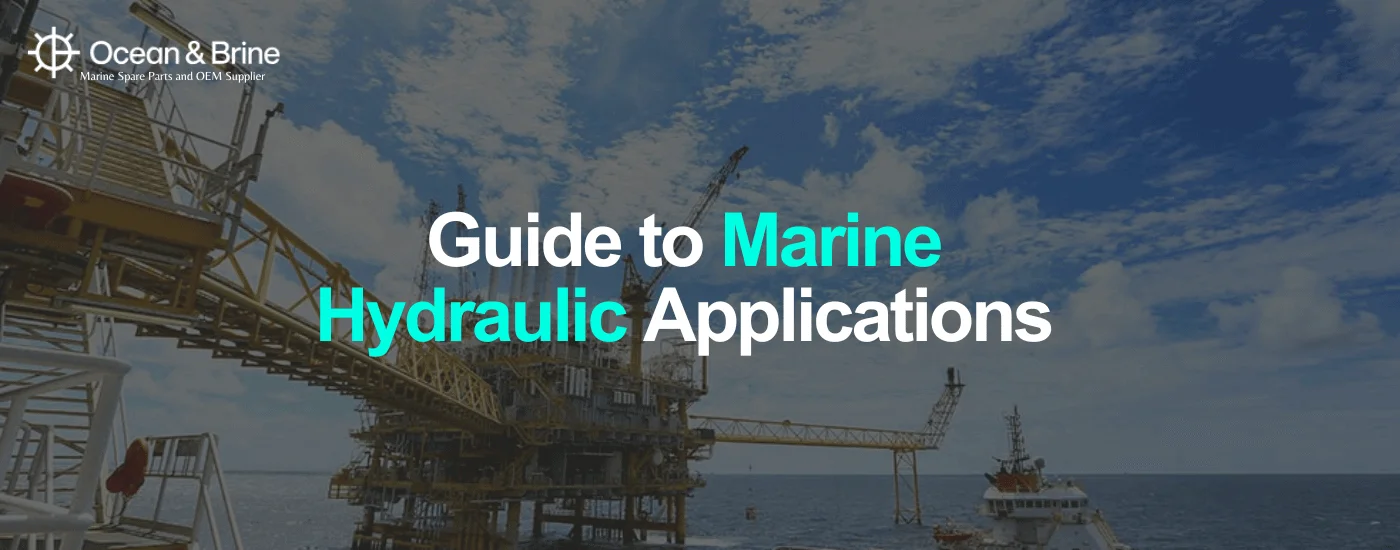Steering and propulsion are two of the main uses of marine hydraulics in the maritime industry. Propellers and thrusters, which push the ship through the water, are powered by hydraulic systems, which also supply power to the steering mechanism of the craft, allowing the vessel to change direction.
Hydraulic systems also regulate the movement of the stabilisers and rudders and keep the ship stable in choppy waters.
To effectively handle large loads, hydraulic systems are also used in winch mechanisms and anchor handling. A wide variety of systems and parts are employed in different capacities on ships, boats, offshore platforms, and other maritime vessels for marine hydraulic applications.
What are the different marine hydraulic systems?
Marine hydraulic motors and pumps are the two types of hydraulic systems that help in driving various systems and gear in maritime vessels. Marine hydraulic solutions form a part of your vessel’s marine safety equipment.
The primary distinction between hydraulic pumps and hydraulic motors is their respective functions. While motors convert hydraulic energy into mechanical energy, pumps convert mechanical energy into hydraulic energy.
Let us dive deeper into the two types of pumps:
Marine Hydraulic Pumps: Gear Pumps, Piston pumps and Vane Pumps are the three different types of hydraulic pumps that fit into the whole gamut of marine spares and equipment.
These hydraulic pumps produce the hydraulic fluid flow required to energise hydraulic systems and trigger motors, cylinders, and other parts. They transform mechanical energy into hydraulic energy, derived from engines or electric motors.
Hydraulic pumps are employed in propulsion systems, winches, cranes, steering systems, anchor handling apparatus, and other deck machinery on ships. They are also used in hydraulic power units (HPUs) to supply supplemental power to hydraulic systems.
Marine Hydraulic Motors: Hydraulic piston motors, hydraulic gear motors and hydraulic vane motors are the key types of marine hydraulic motors.
Hydraulic motors are used to power a variety of machinery and equipment on ships by converting hydraulic energy from pressurised fluid into mechanical energy. Propulsion systems, winches, thrusters, and other marine hydraulic equipment frequently employ these motors.
Hydraulic motors are essential parts of propulsion systems, which use them to power waterjets or propellers to move a vessel forward or backwards. They are also utilised in winches for mooring, towing, anchoring, and handling cargo.
Common applications of hydraulic marine systems:
- Steering Systems: Ships and boats with hydraulic steering systems
- Anchor Handling: Windlasses and hydraulic winches for anchor handling tasks
- Cargo Handling: For cargo handling, hydraulic cranes and lifting apparatus are used
- Propulsion Systems: Marine propulsion hydraulic systems (waterjets, variable pitch propellers)
- Braking Systems: Marine vehicles use hydraulic braking systems
What are the components of marine hydraulic applications?
- Pumps: Vane, piston, and gear pumps
- Valves: Flow, pressure, and directional control valves
- Actuators
- Fluids: Mineral oil-based and biodegradable fluids
What are the various uses of hydraulic applications in ships?
Hydraulics for marine applications are critical to vessels because it uses fluids to transfer power and energy. Its uses in the maritime industry include crane and winch operations, door opening and closing, and heavy machinery control.
Steering and propulsion are two of the main uses of hydraulic systems in the maritime industry. Propellers and thrusters, which push the boat through the water, are powered by hydraulic systems, which also supply power to the steering mechanism of the craft, allowing it to change direction.
Are hydraulic applications reliable and safe?
Hydraulic applications, when properly built, maintained, and operated, can be both safe and reliable. Here are a few things to consider about marine hydraulic applications:
- Design: Ensuring the dependability and security of hydraulic systems requires proper design. This entails choosing the proper parts—such as hoses, cylinders, pumps, and valves—and making sure they are sized and set up appropriately for the intended use
- Materials and Construction: To avoid leaks, corrosion, and other possible risks, high-quality materials and construction methods are crucial. Components should be constructed from sturdy materials that can tolerate the strains and pressures applied within the system
How to maintain Hydraulic applications?
For marine hydraulic systems to operateoptimally, regular maintenance is compulsory. This includes examining for marine hydraulic repairs, changing out damaged marine hydraulic components, using marine hydraulic spare parts, monitoring fluid levels, and quality, and quickly resolving any problems to avoid setbacks.
Avoid leaks, pollution, and component failures with proper installation, operation, and monitoring. Safety protocols, protective coverings, and pressure release valves are only a few examples of the safety precautions that are essential to avert mishaps and guarantee the security of those operating hydraulic systems on board ships.
It is critical to use clean, premium hydraulic fluid to avoid contamination and preserve system performance. Fluid contamination can lead to system failures, decreased efficiency, and component wear.
Marine suppliers of Hydraulic Motors & Pumps
Here is a comprehensive list of marine hydraulic equipment suppliers whose marine spare parts can be sourced from Ocean and Brine’s dedicated product catalogue:
Daito Pump Kogyo, Ebara, Fujita Seisakusho, Heishin Engineering & Equipment, Heishin Pump Works, Ishii Machinery Works, Kashiwa, Naniwa Pump, Taiko Kikai Industries, Teikoku Machinery Works, Georim, Hanyoung, Shin-Shin, Heishin, Naniwa, Shinko, Taiko Kikai, Teikoku, Allweiler, Bornemann, Desmi, Edur, Grundfos, Itur, Imo, Kral, Ksb, Netzsch, Rickmeier, and Seepex.
